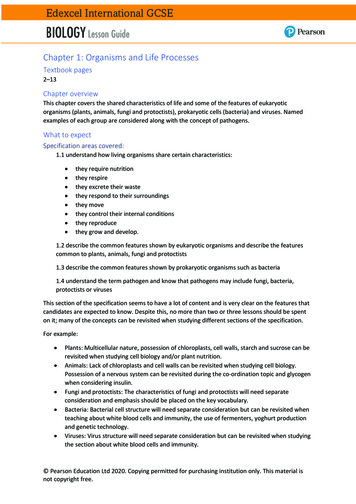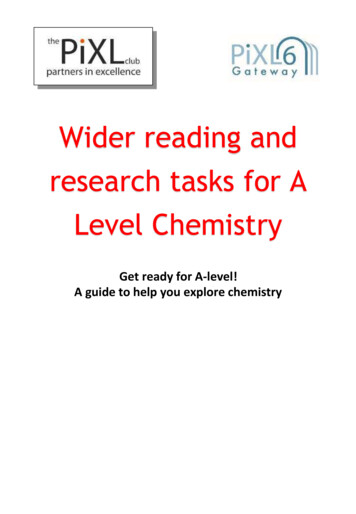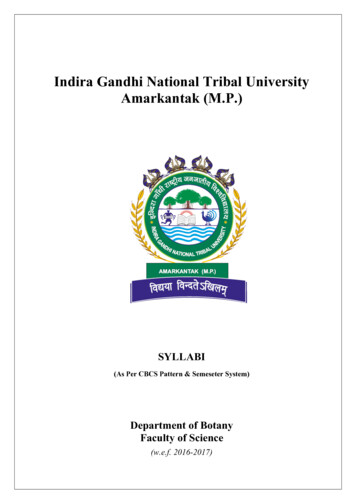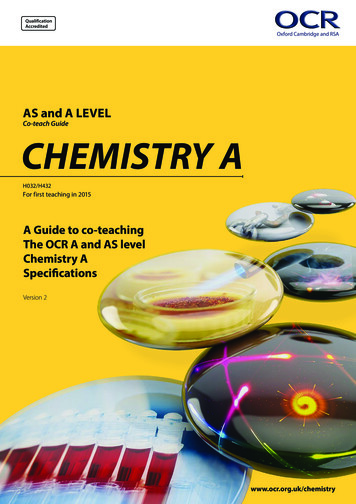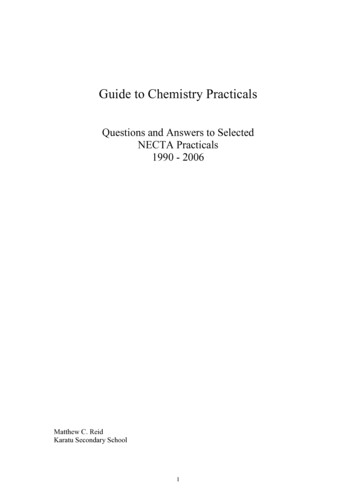
Transcription
Guide to Chemistry PracticalsQuestions and Answers to SelectedNECTA Practicals1990 - 2006Matthew C. ReidKaratu Secondary School1
TABLE OF CONTENTSIntroductionNotes on Units and FormulasPage 3Page 4QuestionsAcid-Base TitrationQuestion 1 (NECTA 1999)Question 2 (NECTA 1995)Question 3 (NECTA 2006)Question 4 (NECTA 1994)Page 7Page 8Page 9Page 10Redox TitrationQuestion 5 (NECTA 1993)Question 6 (NECTA 1997)Question 7 (NECTA 2003)Question 8 (NECTA 2005)Question 9 (NECTA 1990)Page 11Page 13Page 14Page 15Page 16Reaction RateQuestion 10 (NECTA 1990)Question 11 (NECTA 2000)Question 12 (NECTA 1992)Question 13 (NECTA 1999)Question 14 (NECTA 1994)Page 17Page 18Page 19Page 20Page 22Partition CoefficientQuestion 15 (NECTA 2006)Page 23AnswersQuestion 1Question 2Question 3Question 4Question 5Question 6Question 7Question 8Question 9Question 10Question 11Question 12Question 13Question 14Question 15Page 25Page 27Page 29Page 30Page 32Page 34Page 35Page 37Page 38Page 40Page 42Page 43Page 45Page 47Page 492
IntroductionThe purpose of this booklet is to guide A-level chemistry students through the questions thatare likely to appear on NECTA Paper 3, the practical paper. This booklet is not a replacement for theactual practical; it is very important that students are able to perform the practical on their own, andhave lots of practice with experimental procedures and data collection. Instead, this booklet is meant tohelp students with the calculations and questions that come after the data has been collected.How to use this bookletThe first part of this booklet contains 15 practical questions, all of them from past NECTAexams. The questions are written exactly as they are written on the NECTA exams. As you read theprocedure, imagine that you are performing the experiment yourself. Ask yourself: What colourchange should I see? What compound is in the pipette? Which is in the burette? What is the reactionthat is taking place now?After a question, experimental data is provided. It is filled into the results tables in the sameway that a student would write the data if he or she were doing the experiment.Now the student should use the provided data to perform any necessary calculations, drawgraphs if necessary, and answer the questions. Sample calculations, graphs, and answers are providedat the end of the booklet. Students should attempt the calculations on their own before looking at theanswers, however.AcknowledgementsI am indebted to my students at Karatu Secondary School, especially the 2005-2007 CBA,CBG, and PCB students. They performed many of these practicals, helped to collect much of the dataused in this booklet, and provided insight into which questions and calculations will be most difficultfor Tanzanian students, and how best to answer these questions in a sensible way.3
Notes on Units and FormulasA. VolumeThe units of volume commonly used in this manual are cm3 and dm3. The conversionbetween cm3 and dm3 is 1 dm3 1000 dm3. Note that a cm3 are the same as millilitres (ml) and dm3 arethe same as litres (L). 1 cm3 1 ml and 1 dm3 1 L.B. ConcentrationConcentration is a measure of amount per volume. The amount can be grams, kilograms,number of moles, or any other unit of amount. Volume can be cm3, dm3, or any other volume. Thetwo types of concentration used commonly are mol/dm3 and g/dm3.(i) mol/dm3 is also called Molarity or molar concentration. The symbol for molarity is M.Molarity is used in the MAVA formula.(ii) g/dm3 is called gram concentration.To convert from molar concentration to gram concentration, you multiply the molarconcentration by the molar mass of the molecule.To convert from gram concentration to molar concentration, you divide the gramconcentration by the molar mass of the molecule.C. The Mole ConceptA mole (mol) is a unit of amount. 1 mol of something is equal to 6.022x1023 of that thing.For example, 1 mol of H2 molecules is equal to 6.022x1023 H2 molecules. 1 mol of goats is 6.022x1023goats.There are two important formulas for determining the number of moles present of acompound. The first:You see that when you cancel the units, you are left with moles.The second formula:where M molarity (in mol/dm3) and V volume (in dm3). Notice that when you cancel the units, youare left with moles.D. StoichiometryStoichiometry is the study of the relationships between amounts (number of moles or masses)of reactants and products. It is fundamental to all of chemistry, and it is essential that you understandthe stroichiometry and are able to apply it to numbers of moles and masses in chemical reactions.Quantitative reactions are reactions that continue until one of the reactants is finished.Reactions with a strong acid or strong base are quantitative, as are most of the reactions in redoxtitrations. If the reaction proceeds in only one direction (and is not reversible), it is a quantitativereaction. Usually the NECTA exam will state if a reaction is quantitative. If the question states thatsomething "is in excess," this means that there is a very large amount of it, so much that it will not befinished in the reaction.The mol ratio between two compounds is the ratio in which those two compounds react. Forexample, in the reaction:NH3 O2 NO H2OOne mol of NH3 reacts with one mol of O2 to form one mol of NO and one mol of H2O. If 8.5g of NH3 react with 32 of O2, how many grams of NO will be formed? When comparing therelationships between two compounds in a reaction, you must look at the mole relation! The massrelation does not tell us very much. Converting to moles, we see that there are 0.5 moles of NH3 and 1mole of O2.Which of the reactants will be finished first, or will both be finished at the end of the reaction?NH3 will be finished first, since there are only 0.5 mols of it present and NH3 and O2 react in a 1:1mole ratio.4
How many moles of NO will be formed? NH3 and NO have a 1:1 mol ratio, so 0.5 mols ofNH3 will produce 0.5 mols of NO. 0.5 moles of NO has a mass of 15 grams.So you can see that in order to determine the relationship between reactants and products, wemust first compare the number of moles! Once we have determined the mole relation, we can convertfrom number of moles to grams.Another example: In the reaction:I2 2 S2O32- S4O62- 2 I1 mol of I2 reacts with 2 mol of S2O32- to produce 1 mol of S4O62- and 2 mol of I-. This givesus no information about the actual number of moles of these compounds, only about the ratio in whichthey react. It means that 1 mol of I2 requires 2 mol of S2O32- to react completely. Or: 0.25 mol of I2requires 0.5 mol of S2O32- to react completely. The ratio must me 1:2. But the actual number of molescan be 0.25 mol I2 and 0.5 mol S2O32-, or 2 mol I2 and 4 mol S2O32-, or 10 mol I2 and 20 mol S2O32-.To find the actual number of moles, you can use cross-multiplication. You could be asked:0.0125 mol of S2O32- requires how many moles of I2 to react completely? You know that the mole ratiobetween S2O32- and I2 is 2:1. Thus:We would find that x 0.00625 mol I2 would be required to completely react with 0.0125 mol 2 S2O32-.Note that the relationship between the two compounds is between number of moles, not mass.For example, it is true that 1 mol of I2 reacts with 2 mol of S2O32-, but this does not mean that 1 gram ofI2 reacts with 2 grams of S2O32-. You must think of these relationships in terms of numbers of moles!E. The Dilution FormulaThe dilution formula allows you to determine the molarity of a solution after it has beendiluted. The formula is:M1V1 M2V2Where M1 and V1 are the molarity and volume before a dilution, and M2 and V2 are the molarity andvolume after a dilution.Consider this example from the 2006 NECTA: "Hydrochloric acid solution made by diluting750 cm3 of 0.25 M HCl to 937.5 cm3 with distilled water." What is the molarity of this solution afterdilution?The volume before dilution (V1) was 730 cm3, and the molarity before dilution (M1) was 0.25M. The volume after dilution (V2) was 937.5 cm3. To find the molarity after dilution, M2, we simplysubstitute the known values into the dilution equation and solve for M2. We find that M2 0.2 M.Whenever you are given both a molarity and volume before a change (M1 and V1) and areasked to calculate a volume or molarity after a change (V2 or M2), the dilution formula is a good way tofind the answer.F. MAVAThe complete form of MAVA is shown below:MA is the molarity of compound A, VA is the volume of compound A, MB is the molarity of compoundB, and VB is the volume of compound B. nA and nB are the mole ratio between compounds A and B,found from the balanced chemical equation. This equation is extremely important in chemistrypracticals. It is used in acid-base titrations, redox titrations, and is sometimes needed in kinetics andsolvent extraction questions. You can use it to solve for any part of the formula: MA, VB, anything. Ifyou can find values for five of the terms, you will be able to calculate the sixth.Exercises:1. In the reaction I2 2 S2O32- 2 I- S4O62-, 12.7 g of I2 would require how many grams ofsodium thiosulphate for complete reaction?2. You mix 250 cm3 of a 0.1 M HCl solution with 500 cm3 of a 0.08 M NaOH solution. WillHCl or NaOH be in excess? How many moles of the compound will remain? What will be themolarity of the solution?5
3. CuSO4 reacts with KI to produce I2 in the following reaction:2 Cu2 4 I- Cu2I2 I215.9 g of CuSO4 react with 4.15 g of KI. Which reactant will finish first? What amount of I2 will beformed (in moles and grams)?4. Consider the two reactions:IO3- 5 I- 6 H 3 H2O 3 I2I2 2 S2O32- S4O62- 2 I21.4 g of potassium iodate (KIO3) would react with an excess of iodide ions to produce whatmass of I2? This I2 produced in the first reaction would require how many moles of sodiumthiosulphate (Na2S2O32-) to be used up? Hint: use the mole ratio between IO3- and S2O32- to answer thislast question.Answers:1. 15.8 grams2. NaOH will be in excess. 0.015 moles of NaOH will remain after reaction with HCl,producing a solution with a molarity of 0.02 M NaOH3. The KI will finish first. The reaction will produce 0.00625 moles if I2, or 1.59 grams ofI 2.4. 21.4 grams of potassium iodate is 0.1 moles of potassium iodate. This will form 0.3 molesof I2.0.1 moles of potassium iodate will produce enough iodine to react with how many moles ofthiosulphate ions? We can find the mole ratio between iodate ions and thiosulphate ions and then usecross-multiplication.How can we find the mole ratio between IO3- and S2O32-? They are in two different equationsso they are difficult to compare? Well, we see that there is 1 mol of IO3- and 2 mol of S2O32-, so themole ratio must be 1:2. NO!!!! This is not correct!We must add the two equations together in such a way that I2 cancels. I2 allows you totranslate between these two equations. How can we do this? We see that in the first equation there are3 I2 on the product side, and in the second equation there is one I2 on the reactant side. We mustmultiply the second equation by 3, and then add the two together.IO3- 5 I- 6 H 3 H2O 3 I23 I2 6 S2O32- 3 S4O62- 6 I- (the equation has been multiplied by 3)Adding these two equations together, we get:IO3- 5 I- 6 H 3 I2 6 S2O32- 3 H2O 3 I2 3 S4O62- 6 ICancelling the compounds that appear on both sides:IO3- 6 H 6 S2O32- 3 H2O 3 S4O62- 1 IWe see that the correct mole ratio between IO3- and S2O32- is 1:6.Using cross-multiplication, you would find that 0.1 moles of potassium iodate would produceenough iodine to react with 0.6 moles of sodium thiosulphate.6
QuestionsQuestion 1 – NECTA 1999, Chemistry 3AAcid-Base TitrationYou are provided withA1: A mixture containing Sodium hydroxide, NaOH and Sodium Carbonate, Na2CO3A2: 1M Hydrochloric Acid, HClA3: Phenolphthalein IndicatorA4: Methyl OrangePROCEDURE Pipette 20 cm3 (or 25 cm3) of A1 into a clean conical flask and titrate with A2 using A3 until thecolour changes from red to colourless. Record the first end point. Put A4 to the colourless mixture obtained in the previous procedure, and then continue titrating untilthe colour changes from yellow to just red. Record the second end point.RESULTS:The volume of the pipette used was cm3Burette ReadingsTitrationSecond end point (V2 cm3)First end point (V1 cm3)Initial volume (Vo cm3)Volume used (V2-Vo)Volume used (V2-V1)Pilot123NB: There was an error in the exam question. The fifth row on the exam said: “Volume used(V2-Vo).” It should say “Volume used (V1-Vo)Summary:cm3 of Solution A1 required cm3 of A2 in the presence of A3 forcomplete neutralization.cm3 of Solution A1 required cm3 of A2 in the presence of A4 forcomplete neutralization.(a) Write the ionic equations for the reactions taking place in this experiment.(b) Calculate:(i)The volume of HCl required for complete neutralization of Na2CO3(ii)The volume of HCl required for complete neutralization of NaOH(iii)The molarity of Na2CO3(iv)The mass of NaOH and that of Na2CO3 in the mixture7
Experimental DataThe volume of the pipette used was 25 cm3TitrationPilot123Second end point (V2 cm3)30.330.129.729.8first end point (V1 cm3)17.6 17.717.417.3initial volume (Vo cm3)0000volume used (V1-Vo)Volume used (V2-V1)NB: The error in the exam question has been fixed, so that the fifth row now says: “Volume used(V1-Vo), which is what it should say.Summary:cm3 of Solution A1 required cm3 of A2 in the presence of A3 forcomplete neutralization.cm3 of Solution A1 required cm3 of A2 in the presence of A4 forcomplete neutralization.Now you, the student, need to fill out the remainder of the table, the summary and answer thequestions.Question 2 -- NECTA 1995, Chemistry Paper 3Acid-Base TitrationYou are provided with the following solutions:PP is a solution containing hydrochloric acid and acetic acidOQ is a 0.1M sodium hydroxide solutionMO is Methyl Orange IndicatorPOP is Phenylpthalein IndicatorPROCEDURE:(a) Pipette 20cm3 of 25 cm3 of solution PP into a 250 cm3 titration flask.(b) Add 2 or 3 drops of MO(c) Titrate the solution against solution OQ until a colour change is observed(d) Record the first titre value(e) Add 2 or 3 drops of POP(f) Continue to titrate until a second colour change is observed(g) Record the second titre value(h) Repeat your titrations (steps (a) - (g) four or five times and record your results as shown below.RESULTS:The volume of the pipette used was .cm3The volume of the burette used was cm3BURETTE READINGS:Titration numberPILOT 1231. Initial Reading2. Final Reading using MO3. Final Reading using POP4. First titre value (2-1) usingMO5. Second titre value (3-2)using POP8
SUMMARY: .cm3 of solution PP required .cm3 of solution OQ when MO was used and cm3 ofsolution OQ when POP was used.(a) The colour change for the titration using MO was from to . and for the titrationwhen POP was used was from . to (b) (i) MO is a good indicator for titration of strong base against acid(ii) POP is a good indicator for titration of strong base against .acid(c) (I) The first titre value signifies the titration of against sodium hydroxide(ii) The second titre value signifies the titration of . against sodium hydroxide(d) Give the balanced chemical equations for the titration of sodium hydroxide against(i) acetic acid(ii) hydrochloric acid(e) Calculate the concentration of the acid solution PP in mol dm-3 when POP was added and when MOwas added.(f) Calculate the amount of hydrochloric acid in 1 dm3 of solution PP in grams(g) Calculate the amount of acetic acid in 1 dm3 of solution PP in grams.Experimental DataThe volume of the pipette used was 20 cm3The volume of the burette used was 50 cm3BURETTE READINGS:Titration number1. Initial Reading2. Final Reading using MO3. Final Reading using POP4. First titre value (2-1) usingMO5. Second titre value (3-2)using 5.9SUMMARY: .cm3 of solution PP required .cm3 of solution OQ when MO was used and cm3 ofsolution OQ when POP was used.The information provided is enough to complete the table, fill in the summary, and answer thequestions.Question 3 -- NECTA 2006, Chemistry Paper 3AAcid-Base TitrationYou are provided with:AA1: Solution mixture of Na2CO3 xH2O and NaHCO3 made by dissolving 6.4125 of hydrated sodiumcarbonate contaminated with 1.05 g of pure sodium hydrogen carbonate in distilled water and thenmaking up the volume of the solution to 250 cm3.AA2: Hydrochloric acid solution made by diluting 750 cm3 of 0.25 M HCl to 937.5 cm3 with distilledwater.AA3: Methyl orange indicator9
Theory:When a mixture of sodium carbonate and sodium bicarbonate solution is titrated with dilutehydrochloric acid in presence of methyl orange indicator, they react quantitatively as shown inequations I and II below:Na2CO3 2 HCl 2 NaCl H2O CO2 . INaHCO3 HCl NaCl H2O CO2 IIProcedure:(i) Pipette 20 or 25 cm3 of Solution AA1 into a titration flask.(ii) Titrate the pipetted portion of AA1 against AA2 from a burette using two to three drops of methylorange AA2 as indicator. Note the volume of AA2 used.(iii) Repeat procedures (i) and (ii) above to obtain three more readings and tabulate your results asshown below.(a) RESULTS:Burette Readings:Titration numberFinal reading (cm3)Initial Reading (cm3)Titre Volume (cm3)Pilot123(b) cm3 of AA1 required cm3 of AA2 for complete reaction(c) Calculate the molarity of AA2(d) Calculate the molarity of AA1 with respect to:(i) NaHCO3(ii) Na2CO3 xH2OExperimental ResultsBurette Readings:Titration numberFinal reading (cm3)Initial Reading (cm3)Titre Volume (cm3)Pilot28.90.00128.80.00228.80.00328.60.00(b) 25 cm3 of AA1 required cm3 of AA2 for complete reactionThis information is enough for you to fill in the rest of the results table and answer the questions.Question 4 -- NECTA 1994, Chemistry Paper 3CAcid-Base TitrationYou are provided with:TT: a solution of an ammonium salt whose general formula is (NH4)x prepared by dissolving6.60 g of the salt in 1000 cm3 of water.SS: 0.15M sodium hydroxide solutionZZ: 0.025M sulphuric acid.10
Procedure:Pipette 20 cm3 (or 25cm3) of solution TT into a beaker and then pipette an equal volume ofsolution SS into the same beaker. Boil the mixture gently until the steam being evolved isneutral to moist red litmus paper. Cool the mixture in a water bath, then titrate the excess SSin the mixture against solution ZZ using phenolpthalein (POP) as your indicator.Repeat this procedure to obtain two or three more readings and record your results as shownbelow.RESULTS:The volume of the pipette used was cm3The volume of the burette used was cm3BURETTE READINGS:Titration NumberPilot123Final reading (cm3)Initial reading (cm3)Titre (cm3)SUMMARY:The solution mixture required . cm3 of solution ZZ for complete neutralization of excessSS.Calculate:(a) the volume of excess SS in the mixture(b) The volume of SS used to liberate ammonia from a single portion of solution TT(c) The mass of ammonia expelled from the mixture(d) The total mass of nitrogen in the expelled ammonia(e) The percentage by weight of ammonia in the saltExperimental ResultsThe volume of the pipette used was 25 cm3The volume of the burette used was 50 cm3Titration NumberFinal reading (cm3)Initial reading (cm3)Titre (cm3)Pilot33.80.0133.60.0233.70.0333.70.0The solution mixture required . cm3 of solution ZZ for complete neutralization of excess SS.The information provided above is enough for you to fill in the remainder of the data table, completethe summary, and answer the questions.Question 5 – NECTA 1993, Chemistry Paper 3Redox TitrationYou are provided with:KK: a solution of hydrogen peroxide obtained by reacting 7.2g of impure barium peroxide with dilutesulphuric acid and making the solution to 1 dm3, using distilled water, after filtering.GG: A solution of potassium permanganate containing 3.0g of KMnO4 per dm3HH: A 2M sulphuric acid solution.11
A quantitative reaction occurs between barium peroxide and dilute sulphuric acid according to theequationBaO2(s) H2SO4(aq) BaSO4(s) H2O2(aq)PROCEDURE:Pipette 20 cm3 (or 25 cm3) of solution KK into a conical flask, add to it about 25 cm3 of 2M HH andtitrate this mixture with solution GG until a permanent pink colour is observed.Repeat this procedure for at least three times. Record your titration results in tabular form as shownbelow.RESULTS:The volume of the pipette used was . cm3The volume of the burette used was . cm3BURETTE READING:Titration NumberPilotFinal reading(cm3)Initial reading(cm3)Titre (cm3)123SUMMARY: . cm3 of solution KK needed . cm3 of solution GG for complete reaction.(a) Write an ionic equation for the reaction between hydrogen peroxide and potassium permanganatein excess of dilute sulphuric acid.(b) Calculate the concentration of hydrogen peroxide in(i) mole/dm3(ii) g/dm3(c) What was the percentage purity of barium peroxide used?Experimental ResultsThe volume of the pipette used was 25 cm3The volume of the burette used was 50 cm3Titration NumberFinal reading(cm3)Initial reading(cm3)Titre 615.915.8SUMMARY: . cm3 of solution KK needed . cm3 of solution GG for complete reactionThe information provided is enough for you to fill out the remaining boxes in the results table.After filling these boxes, you can complete the summary and answer the questions.12
Question 6 – NECTA 1997, Chemistry Paper 3ARedox TitrationYou are provided with:FA1: A solution made by dissolving 3.25 g of impure Potassium dichromate (K2Cr2O7) in 500cm3 ofdistilled water.FA2: A solution made by dissolving 12.40g of sodium thiosulphate pentahydrate (Na2S2O3 5H2O) in500 cm3 of distilled water.FA3: 10% Potassium Iodide SolutionPROCEDURE:1. Pipette 20.0cm3 (or 25.0cm3) of FA1 into a clean conical flask. Add to it 20 cm3 of bench diluteH2SO4 and 20 cm3 of Potassium Iodide solution.The Potassium Iodide is in considerable excess, and Iodine is liberated according to the equationCr2O72- 6 I- 14 H 2 Cr3 3 I2 7 H2O2. Titrate the liberated Iodine with FA2, using starch as an indicator.Quantitative reaction takes place between Iodine and the thiosulphate ion.I2 2 S2O32- S4O62- 2 IThe end point is when the blue colour of the starch-Iodine complex is just replaced by the GREENcolour of Cr3 ions.RESULTSThe volume of the pipette used was cm3Burette Readings:TitrationPilot123Final volume (m3)Initial volume(cm3)Volume used(cm3)Note: There is an error in the question. The units for final volume should be cm3, not m3.Summary: .cm3 of FA1 liberated sufficient Iodine to oxidize .cm3 of FA2.Calculate:(a) The molarity of the potassium dichromate, K2Cr2O7(b) The concentration of the potassium dichromate in g/dm3(c) The percentage purity of the potassium dichromateExperimental ResultsThe volume of the pipette used was 25 cm3TitrationPilot123Final volume19.419.1 19.4 19.2(cm3)Initial volume0.00.00.00.0(cm3)Volume used(cm3)Note: the table has been corrected so that the units for final volume are cm3, not m3.Summary: .cm3 of FA1 liberated sufficient Iodine to oxidize .cm3 of FA213
The information provided in this table is enough for you to fill out the summary and then answer thequestions.Question 7 – NECTA 2003, Chemistry 3ARedox TitrationYou are provided with:A1: a solution of copper(II) sulphate (CuSO4), obtained by reacting 9 g of impure copper (II) oxide(CuO) with dilute sulphuric acid and making the solution to 1 dm3 using distilled water after filtering.A2: a solution made by dissolving 12.40g of Na2S2O3 5H2O in 500 cm3 of distilled water.A3: A solution of 10% KIA4: A starch solution.Theory:A quantitative reaction occurs between copper (II) oxide and sulphuric acid according to the equationgiven below:CuO H2SO4 CuSO4 H2O . (1)The copper (II) sulphate obtained reacts quantitatively with potassium iodide to liberate iodine asfollows:2 Cu2 (aq) 4 I-(aq) Cu2I2(s) I2(s) . (2)The liberated iodine can be titrated against sodium thiosulphate and the reaction taking place during thetitration can be represented as follows:2 S2O32-(aq) I2(s) S4O62-(aq) 2I-(aq) (3)Procedure:(a) Pipette 20.00cm3 (or 25.00cm3) of solution A1 into a conical flask.(b) Add about 20 cm3 of A3 solution from a measuring cylinder and shake the mixture.(c) Titrate the mixture with solution A2 from the burette until the solution changes to light brownishin colour.(d) Add about 2 cm3 of solution A4.(e) Continue with the titration until the pale blue colour just disappears and a milky colour appears.Record your results in tabular form as shown below: (Table 1)Results:The volume of the pipette used was The volume of the burette used was Table 1: Burette ReadingsTitration numberPilot1Final reading (cm3)Initial reading (cm3)Titre volume used (cm3)23Summary: cm3 of solution A1 liberated iodine which required . cm3 of A2for complete reaction.Questions:(a) Calculate the concentration of A2 in moles per litre(b) Calculate the molarity of A1(c) Calculate the concentration of A1 in g/dm3(d) Find the percentage purity of copper (II) oxide (CuO)14
Experimental ResultsThe volume of the pipette used was 25 cm3The volume of the burette used was 50 cm3Titration numberFinal reading(cm3)Initial reading(cm3)Titre volume s information is enough for you to fill out the remaining cells in the table and to answer thequestions.Question 8 --NECTA 2005, Chemistry 3ARedox TitrationYou are provided with the following solutions:D1: is a solution containing 13 g of an impure iodine in 1 dm3 of aqueous solutionD2: is a solution containing 0.025 moles of Na2S2O3 5H2O in 250 cm3 of aqueous solution- Starch IndicatorTheory:Iodine reacts with sodium thiosulphate quantitatively as indicated in the reaction below:I2 2 S2O32- S4O62- 2 IProcedure:(a) Pipette 25 cm3 (or 20cm3) of solution D1 into a conical flask.(b) Put D2 into the burette and note the initial reading(c) Titrate solution D1 against solution D2 from the burette until the solution is pale yellow. Addstarch indicator and continue to titrate until the blur colour is discharged.(d) Note the volume of D2 used.(e) Repeat procedures (a) to (d) to get three more readings(f) Record your results in the table as shown below.Results:The volume of the pipette used was cm3.Burette readings:Titration NumberPilot12Final reading (cm3)Initial Reading (cm3)Volume used (cm3)3Summary: cm3 of solution D1 required cm3 of solution D2 for complete reaction.Questions:(a): Calculate the concentration of D2 in moles per dm3.(b) Calculate:(i) The molarity of pure iodine(ii) The concentration of pure iodine in g/dm3(iii) The percentage purity of iodine(c) Iodine is only slightly soluble in water. Which chemical substance do you think was added intowater to increase the solubility of iodine? Explain15
Experimental ResultsResults:The volume of the pipette used was 25 cm3.Burette readings:Titration NumberPilot1Final reading (cm3)21.120.7Initial Reading (cm3)0.000.00Volume used (cm3)241.220.7320.40.00Summary: cm3 of solution D1 required cm3 of solution D2 for complete reaction.Question 9 -- Necta 1990, Chemistry Paper 3Redox TitrationYou are provided with the following solutions:EF is a 250 cm3 solution containing 1 g of an impure sample of Manganese dioxide (MnO2) and 2.2g ofoxalic acid crystals (C2H2O4 2H2O).GH is a standard solution of 0.02 M potassium permanganate, and dilute sulphuric acid.Manganese dioxide and oxalic acid react quantitatively as follows:MnO2 2 C2H2O4 Mn2 2 H2O 2 CO2 And the excess oxalic acid reacts quantitatively with potassium permanganate as follows:2 MnO4- 5 C2H2O4 16H 2 Mn2 8 H2O 10 CO2 (Note: The first equation is not balanced. If you encounter a mistake like this on the NECTA exam,make a note but then continue to use the given equation. You will note lose points by using theequation that NECTA provides. If balancing the equation is part of the question, however, be sure tobalance the equation.)PROCEDURE:Pipette 20 cm3 (or 25cm3) of EF into a conical flask, add about 20 cm3 of dilute sulphuric acidand heat the contents of the flask to about 80ºC. Titrate the hot EF with GH until the purple colourdisappears. (Note: there is a mistake in the question here. It should read: Titrate the hot EF with GHuntil the purple colour no longer disappears). Repeat this procedure two to three times and record yourtitration results as indicated in the table below.RESULTS:The volume of the pipette used was cm3The volume of the burette used was .cm3BURETTE READINGS:Titration NumberFinal ReadingInitial ReadingTitre (Volume used)Pilot123SUMMARY:For complete reaction, . cm3 of EF required cm3 of GH.Calculate:(a) the molarity of the oxalic acid(b) the concentration of the oxalic acid in g/dm3(c) the percentage purity of the Manganese dioxide in the sample.16
Experimental ResultsThe volume of the pipette used was 20 cm3The volume of the burette used was 50 cm3Titration NumberFinal ReadingInitial ReadingTitre (Volume used)Pilot11.40.0111.30.0222.711.3333.722.7For complete reaction, . cm3 of EF required cm3 of GHThese results are enough for you to fill in the remainder of the table, complete the summary, andanswer the questions.Question 10 – NECTA 1990, Paper 3Reaction Rate – Activation EnergyYou are provided with the following:HI is a solution of 0.05M of sodium thiosulphateJK is a solution of 0.1M Nitric AcidA stopwatch or stopclockA thermometer (0ºC - 100ºC)A white precipitate of amorphous sulphur can be obtained by the action of a dilute acid on sodiumthiosulphate (Na2S2O3) according to the equationS2O32- 2 H2O 3 H2O S SO2 (N
Guide to Chemistry Practicals Questions and Answers to Selected NECTA Practicals 1990 - 2006 Matthew C. Reid Karatu Secondary School . 2 TABLE OF CONTENTS Introduction Page 3 Notes on Units and Formulas Page 4 Questions Acid-Base Titration Question 1 (NECTA 1999) Page 7 Question
